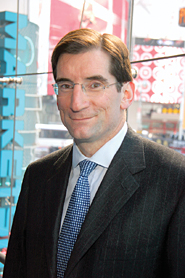NasdaqOMX’s chief executive officer Bob Greifeld shared views on high-frequency trading during the exchange group’s first quarter 2014 earnings on Thursday. Since the HFT debate entered the public spotlight after the release of Michael Lewis’ “Flash Boys,” the earning call soon featured questions about HFT and its impact on the markets. Here are a selection of edited highlights from the call.
Caller: What is NASDAQ OMX’s role, considering criticism that HFTs may be front-running and manipulating markets?
Bob Greifeld: As an SRO that has been awarded three exchange licenses by the SEC in the U.S., we pride ourselves on providing open access in our markets. This is our obligation under the law, and we have been upholding it since 1971. As a result, NASDAQ OMX has long, deep experience with facilitating transactions in the global markets. Transparency is a core value for us.

Caller: What are the products that are affected, and what are the revenues associated with those products?
Greifeld: We can’t predict what others will do, and much of the debate on this topic is conducted using terms about which there is no consistency.
Caller: How should the industry define HFT, or come up with a reasonable analogue to that?
Greifeld: We believe a key indicator of HFT is a high ratio of quotations in comparison to execution orders, and so, for purposes of this discussion, that’s what we are looking at. Others may prefer different measures, but in the spirit of transparency, we are adopting an analysis that focuses on firms that show a high degree of quotations to execution orders.
Caller: What level of quotes does NASDAQ OMX identify as excessive?
Greifeld: You can debate where you should draw the line. So we’re going to show you several lines: 60 all the way up to 100. This is our approach. Again, others may take a different approach. With this beginning, we looked at those market participant IDs, or “MPIDs,” who are not registered market makers with NASDAQ and who had order-to-trade ratios of at least 60 to 1.
Caller: Why exclude market makers?
Greifeld: For the very good reason that under the current regulatory regime, we believe they are putting capital at risk and contributing to price discovery, and thereby benefitting investors. For the purposes of this discussion we’ll call these market participants by the acronym “H.O.T.T” for High Order To Trade.
Caller: How much of NASDAQ OMX’s revenue comes from H.O.T.T. trading?
Greifeld: Our numbers aggregate revenues from the products these firms tend to rely upon given their activities in the Market Data, Access Services and Transactions areas. This category of H.O.T.T. firms, when you aggregate their revenues from our various products, constitutes approximately 1% of our global revenue. Of course, we wouldn’t want to imply that these revenues will be affected. But subjectively speaking, we believe in our model. We believe in our markets. And we believe that they will serve us well in the current debate.
Editor’s Note: This content was provided by the Nasdaq press office.



